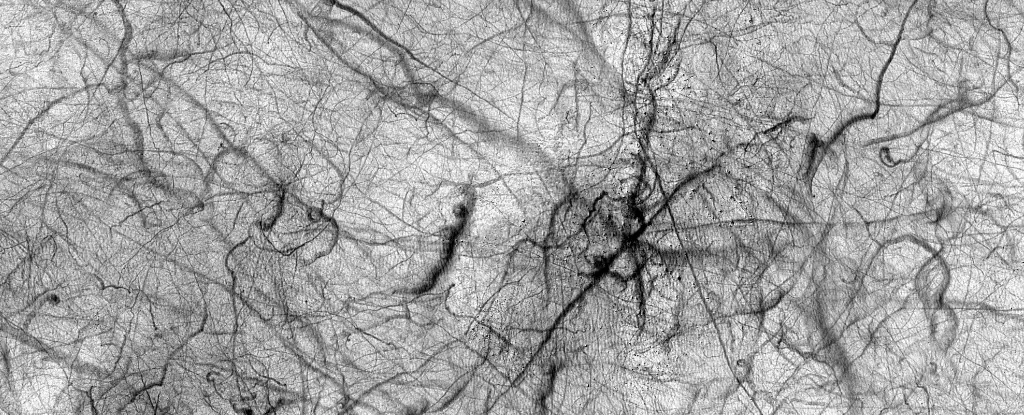In a spectacular revelation from NASA’s Mars Reconnaissance Orbiter, the relentless dance of dust devils has been captured in unprecedented detail. Taken in September 2022 using the high-resolution imaging science experiment (HiRISE) camera, this image showcases the Haldane Crater, where these swirling dust phenomena carve their invisible paths across the rugged Martian landscape. Each dust devil, akin to its terrestrial cousins, forms and disbands cyclically, leaving behind traces that provide valuable insights into Mars’ complex surface processes.
Dust devils are one of the many mysteries of the Martian atmosphere, illustrating the dynamic nature of a planet once thought to be static. They manifest as columns of dust and conflict with the harsh reality of Mars’ environment, which remains inhospitable for unprotected human life.
Mars, the fourth planet from the Sun, is famously dubbed the ‘Red Planet’ due to the iron oxide that blankets its surface, giving it a rusted hue. With a thin atmosphere composed of approximately 95% carbon dioxide and traces of nitrogen and argon, Mars presents a stark contrast to Earth. The Martian environment is unforgiving, with average temperatures lingering around -60 degrees Celsius. This unusual environment has forged a world of great geological wonders, from the colossal shield volcano Olympus Mons to the expansive Valles Marineris canyon system.
Geological studies suggest that Mars had once harbored liquid water and a thicker atmosphere—a revelation that spurs ongoing discussions about the possibility of past life. Understanding this planet’s evolution and present-day phenomena like dust devils is crucial for scientists aiming to unravel the secrets of Martian history and its potential for supporting life.
Similar to tornadoes on Earth, Martian dust devils are formed when the surface temperature rises, prompting warm air to ascend rapidly. This momentum generates a spinning vortex that consumes nearby dust, leading to swirling clouds that can measure several kilometers in width. Interestingly, these devils vary widely in size and intensity; while some may appear harmless and fleeting, others can linger for extended periods, affecting both the Martian weather and the surface itself.
The movement and behavior of dust devils play pivotal roles in dust redistribution across Mars, influencing not just the planet’s weather systems but also its climate. As these whirlwinds traverse the Martian surface, they engage in a complex interaction with the fine particulate matter, lifting dust high into the atmosphere and allowing it to settle across vast distances.
Dust devils present a unique dichotomy for Martian exploration. They are both beneficial and detrimental to the numerous landers and rovers operating on its surface. On one hand, these atmospheric phenomena can act as natural cleaners, removing accumulated dust from solar panels and other sensitive instruments, enhancing their operational efficacy. On the other hand, the same dust can pose significant challenges by covering equipment, blocking sunlight, and ultimately reducing energy output.
Researchers at NASA’s Jet Propulsion Laboratory are meticulously examining these dust devil tracks to better understand the rate of dust deposition and its implications for future missions. By gaining insights into how dust is redistributed, scientists hope to mitigate potential hazards posed by Martian weather patterns in upcoming explorations.
As we endeavor to unlock the mysteries of the Red Planet, studying phenomena like dust devils becomes increasingly significant. The image recently released by NASA JPL not only fascinates the public imagination but also serves a practical purpose for science. By quantifying the rate and distribution of Martian dust, researchers aim to safeguard human instruments from the unpredictable whims of the Martian atmosphere.
As we continue to unravel the complexities of Mars, such studies underscore the importance of understanding our cosmic neighbors. The Red Planet, with its eerie beauty and violent weather patterns, offers a window not just into its own past but also into the broader narratives of planetary evolution and the potential for life beyond Earth. Thus, the swirling dust devils of Mars are much more than mere atmospheric events; they are crucial indicators of the planet’s dynamic systems and our gateway to future exploration.


Leave a Reply